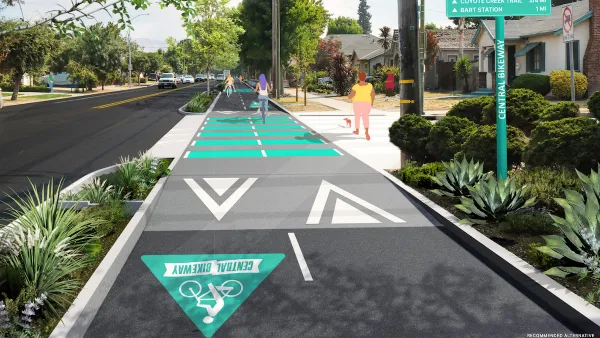Average vehicle miles driven rose in almost every major metropolitan area between 2019 and 2024.

The reduction in driving brought on by the pandemic doesn’t seem to be a lasting effect, writes Linda Poon in Bloomberg CityLab. In fact, between May 2019 and May 2024, total miles traveled (VMT) in the United States grew by 12 percent to the highest level ever recorded, according to a report from StreetLight Data.
The report also suggests that VMT is rising faster now than it was when driving levels first rebounded from the pandemic in 2021 — a worrying trend for advocates working to reform transportation, the largest contributor to US carbon emissions.
VMT grew in almost every U.S. metro area and in most central city neighborhoods, including a 14.7 percent growth in New York City’s core, highlighting the potential benefits of the city’s now-canceled congestion pricing plan.
Across the country, famously car-centric Los Angeles saw a 17 percent decline in average daily VMT. “Other areas among the top five are also in California, including the Oxnard-Thousand Oaks-Ventura area with a 16% decline and the San Francisco Bay Area with a 13% decline — though the study does not dive into potential reasons for the dips.”
Brookings senior fellow Adie Tomer says more work is needed to understand why these changes happen. “Declines in VMT could be a result of deliberate urban planning and infrastructure changes to rein in driving. They could also be a consequence of remote work policies and population shifts, not only away from the metro area but within it.”
FULL STORY: US Driving and Congestion Rates Are Higher Than Ever

Planetizen Federal Action Tracker
A weekly monitor of how Trump’s orders and actions are impacting planners and planning in America.

Silicon Valley ‘Bike Superhighway’ Awarded $14M State Grant
A Caltrans grant brings the 10-mile Central Bikeway project connecting Santa Clara and East San Jose closer to fruition.

Amtrak Cutting Jobs, Funding to High-Speed Rail
The agency plans to cut 10 percent of its workforce and has confirmed it will not fund new high-speed rail projects.

California Set to Increase Electric Truck Chargers by 25%
The California Transportation Commission approved funding for an additional 500 charging ports for electric trucks along some of the state’s busiest freight corridors.

21 Climate Resilience Projects Cancelled by the EPA
The federal government has pulled funding for at least 21 projects related to farming, food systems, and environmental justice to comply with one of Trump’s early executive orders.

Trump Executive Order on Homelessness Calls for Forced Institutionalization
The order seeks to remove legal precedents and consent decrees that prevent cities from moving unhoused people from the street to treatment centers.
Urban Design for Planners 1: Software Tools
This six-course series explores essential urban design concepts using open source software and equips planners with the tools they need to participate fully in the urban design process.
Planning for Universal Design
Learn the tools for implementing Universal Design in planning regulations.
Yukon Government
Caltrans
New Jersey Institute of Technology
Mpact (founded as Rail~Volution)
City of Camden Redevelopment Agency
City of Norman, Oklahoma
City of Portland
City of Laramie





























